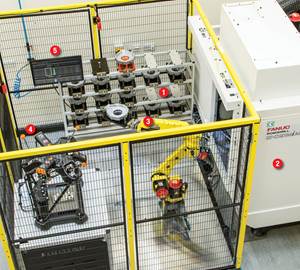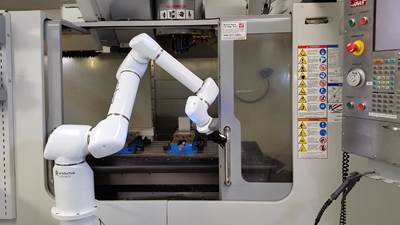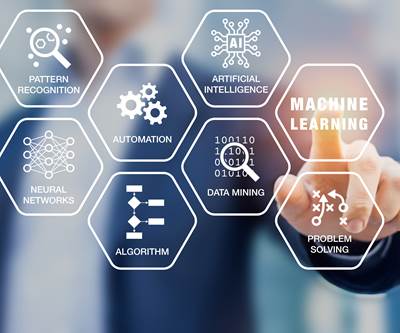After Machine Monitoring, Is Machine Learning the Next Step? Getting Ready for AI in Manufacturing
Is artificial intelligence coming to machine shops? Automatically gathering data is already widespread. Automatically analyzing data is likely the next step. One book offers a useful perspective on what this will and will not mean.
Share





Machine monitoring happened fast. Once the enabling technology was in place to allow real-time gathering and aggregating of performance data from CNCs (MT Connect, for example, is an important enabler), machine shops quickly embraced the capability. Now, the digital dashboard showing pie charts or green/yellow/red displays of machine tool status information has become a commonplace sight in shops, though it was practically nonexistent not many years ago. The change happened so fast that we can reasonably expect the next step after machine monitoring to happen quickly as well. I believe that step is liable to be machine learning.
After all, there is far more data for the machine tools and processes to disclose than just what pie charts show. As machine monitoring systems get better at capturing that data, and as the information available from ERP systems is drawn in as well, the amount of data will soon grow beyond what machine shop personnel can reasonably make sense of day-to-day. However, large data sets are both the resource and requirement for machine learning. Once a few enabling technologies are in place, it seems reasonable to expect that this form of artificial intelligence will help manufacturers comb their performance data automatically to find opportunities to optimize processes or costing through improvements that otherwise might be too subtle or counterintuitive to see.

And yet, data is not wisdom. To get ready for a future in which machine learning is a commonplace tool in industry, a book I’ve found worth reading is The AI Delusion by economist Gary Smith. Contrary to the title, Dr. Smith does not discredit AI, but instead questions the level of faith many place in it. AI simply looks for correlations in big data sets, that’s all. Humans finding correlations in data may or may not find something useful, he notes, and the same is true of AI. When AI comes to manufacturing facilities, it will be another tool in the shop — an effective tool but nothing more.
Some interesting points about AI and data analysis I drew from Dr. Smith’s book include the following:
• Looking for correlations in data and expecting to act on them can be dangerous. Any large data set is going to have correlations that look predictive, but in fact do not mean anything. Patterns are part of randomness. If we find a correlation between two variables (say, discovering the rise in grooving insert tool wear correlates to a rise in job cost overruns), then we should consider the correlation meaningful only if we had good reason to believe the variables were related before looking at the data.
• Big data can be bad data. A big data set can be full of meaningless input that gets in the way of the few measures that are valuable.
• We can always rationalize why a seeming correlation found in data might make sense. This doesn’t make it true. As a test, assume the data suggest the opposite of the prediction you see. Watch how easily you can rationalize that correlation, too.
• The problem described in the points above has already played out in other fields. Seemingly convincing correlations that are actually meaningless are the reason why we’ve seen so many popular medical findings reversed (various substances that have been linked to cancer, for example). In manufacturing, the use of machine learning to mine data sets is going to reveal the same kind of noise.
• The new computational tools are only tools, and our words for them are only analogies. Machines using “artificial intelligence” are not really intelligent. “Machine learning” does not lead to a machine truly learning anything at all. People are the ones who learn (hopefully).
Related Content
Cutting Part Programming Times Through AI
CAM Assist cuts repetition from part programming — early users say it cuts tribal knowledge and could be a useful tool for training new programmers.
Read MoreLean Approach to Automated Machine Tending Delivers Quicker Paths to Success
Almost any shop can automate at least some of its production, even in low-volume, high-mix applications. The key to getting started is finding the simplest solutions that fit your requirements. It helps to work with an automation partner that understands your needs.
Read More5 Stages of a Closed-Loop CNC Machining Cell
Controlling variability in a closed-loop manufacturing process requires inspection data collected before, during and immediately after machining — and a means to act on that data in real time. Here’s one system that accomplishes this.
Read MoreStuder's Automation, Entry-Level Solutions Take Center Stage
At its 2024 Music Motion Meeting, Studer AG showed off its entry-level line of grinding machines, as well as its newest universal loading system.
Read MoreRead Next
What Makes Smart Robots Smart?
How manufacturing technology “thinks,” and the extent to which it should, are critical considerations in applying artificial intelligence intelligently.
Read MoreVideo: The Impact of Artificial Intelligence (AI) on Manufacturing and Machining
The machine tool monitoring that many CNC machining facilities are doing today could be a first step toward their use of machine learning. In this conversation, MMS’s “Data Matters” columnist Matt Danford speculates on the coming role of AI for refining machining processes.
Read More10 Takeaways on How Artificial Intelligence (AI) Will Influence CNC Machining
The Consortium for Self-Aware Machining and Metrology held a promising first meeting at the University of North Carolina Charlotte. Here are my impressions.
Read More























